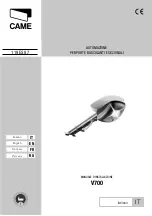
dry wood or other insulating materials to move cables, if necessary away from the person.
•
Wear dry gloves and clothing. Insulate yourself from the work piece or other parts of the welding circuit.
•
Make sure the main line is properly grounded.
•
Do not coil the torch or the ground cables around your body.
•
Never touch or come in physical contact with any part of the input current circuit and welding
current circuit.
Electric warning:
•
Repair or replace all worn or damaged parts.
•
Extra care must be taken when working in moist or damp areas.
•
Install and maintain equipment according to local regulations.
•
Disconnect power supply before performing any service or repair.
•
Should you feel the slightest electrical shock, stop any welding immediately and do not use the
welder until the fault has been found and corrected.
1.5 NOISE
Noise can cause permanent hearing loss. Welding processes can cause noise levels that exceed safe
limits. You must protect your ears from loud moise to prevent permanent loss of hearing.
•
To protect your hearing from loud noise, wear protective ear plugs and/or ear muffs.
•
Noise levels should be measured to be sure the decibels (sound) do not exceed safe levels.
1.6 ELECTROMAGNETIC COMPATIBILITY
Before installing your welder, carry out an inspection of the surrounding area, observing the following
guidelines:
•
Make sure that there are no other power supply cables, control lines, telephone leads or other
equipment near the unit.
•
Make sure that there are no radio receivers, television appliances, computers or other control
systems near the unit.
•
People with pace-maker or hearing-prosthesis should keep far from the power source.
! In particular cases special protection measures may be required.
Interference can be reduced by following these suggestions:
•
If there is interference in the power source line, an E.M.T. filter can be mounted between the power
supply and the power source;
•
The output cables of the power source should be not too uch long, kept together and connected
to ground;
•
After the maintenance all the panels of the power source must be securely fastened in place.
1.7 PROTECTIVE WELDING GASES
Shielding gas cylinders contain gas under high pressure. If damaged, a cylinder can
explode. Treat them carefully.
•
These welders use only inert or non-flammable gases for welding arc protection. It is important to
choose the appropriate gas for the type of welding being performed;
•
Do not use gas from unidentified cylinders or damaged cylinders;
•
Do not connnect the cylinder directly to the welder, use a pressure regulator;
•
Make sure the pressure regulator and the gauges function properly;
•
Do not lubrificate the regulator with oil or grease;
•
Each regulator is designed for use with a specific gas. Make sure the regulator is designed for the
protective gas being used;
•
Make sure that the cylinder is safely secured tightly to the welder with the chain provided.
•
Never expose cylinders to excessive heat, sparks, slag or flame;
•
Make sure that the gas hose is in good condition;
•
Keep the gas hose away from the working area.
15
-ENGLISH-
















































